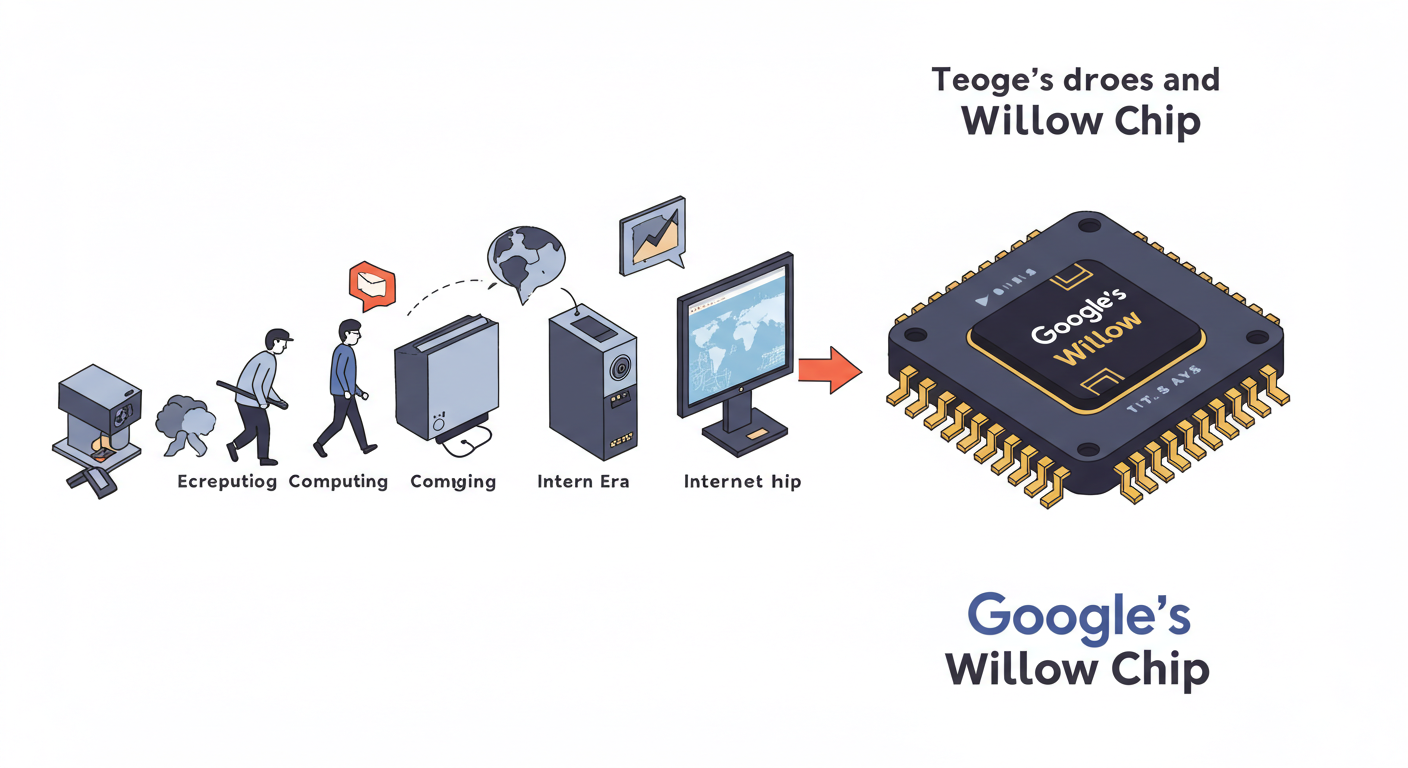
Introduction
The evolution of technology has been one of humanity’s most transformative journeys. From the clunky, room-sized computers of the mid-20th century to today’s sleek smartphones, each leap in computing power has reshaped how we live, work, and interact with the world. But now, we stand on the brink of a new era—one where classical computing principles are being rewritten by the advent of quantum computing.
At the forefront of this revolution is Google’s Willow chip , a groundbreaking development that promises to redefine the limits of computational speed and complexity. In this article, we’ll explore the historical trajectory of computer technology, examine the rise of quantum computing, and take a deep dive into what Google’s Willow chip means for the future of innovation.
The Historical Evolution of Computers
1. The Birth of Electronic Computing (1940s–1950s)
The journey began with machines like the ENIAC (Electronic Numerical Integrator and Computer), unveiled in 1945. Weighing over 27 tons and occupying an entire room, ENIAC was designed to calculate artillery firing tables during World War II. It used vacuum tubes for processing and could perform about 385 operations per second —a far cry from modern capabilities.
This era laid the foundation for stored-program computers with the introduction of the von Neumann architecture , which became the standard blueprint for digital computers.
2. Transistors and Integrated Circuits (1960s–1970s)
The invention of the transistor in 1947 marked a turning point. Smaller, faster, and more reliable than vacuum tubes, transistors enabled the miniaturization of electronic circuits. By the late 1950s, engineers developed integrated circuits , which packed multiple transistors onto a single silicon chip.
This led to the birth of microprocessors like Intel’s 4004 in 1971—the first commercially available microprocessor—and set the stage for personal computing.
3. The Personal Computing Revolution (1980s–1990s)
The 1980s saw the rise of affordable home computers such as the Apple II, IBM PC, and Commodore 64. Software innovations, including Microsoft’s MS-DOS and later Windows, made computing accessible to the masses. The internet explosion in the 1990s further accelerated the integration of computers into everyday life.
4. Mobile and Cloud Computing (2000s–2010s)
The new millennium brought smartphones , cloud computing , and artificial intelligence into mainstream use. Companies like Apple, Google, and Amazon transformed how we access information, communicate, and even think about data storage and processing.
Moore’s Law—which predicted that the number of transistors on a microchip would double every two years—held true for decades, driving exponential growth in computing power. However, as we approach the physical limits of silicon-based chips, the industry has begun looking beyond classical computing models.
Enter Quantum Computing: A New Paradigm
What Is Quantum Computing?
Quantum computing leverages the principles of quantum mechanics —such as superposition and entanglement—to process information in fundamentally different ways than classical computers.
While classical bits represent data as either 0 or 1, quantum bits (qubits) can exist in both states simultaneously. This allows quantum computers to perform certain types of calculations exponentially faster than their classical counterparts.
Key Milestones in Quantum Computing
- 1994 : Peter Shor develops Shor’s algorithm , showing that a quantum computer could factor large integers efficiently—an implication for breaking encryption.
- 2019 : Google claims quantum supremacy using its Sycamore processor , completing a task in 200 seconds that would take the world’s fastest supercomputer 10,000 years.
- 2023–2024 : Continued advancements in error correction, qubit stability, and hybrid quantum-classical systems push the field closer to practical applications.
Introducing Google’s Willow Chip: A Leap Forward
In early 2025, Google announced the Willow chip , marking a significant milestone in quantum computing research. Named after the tree symbolizing resilience and adaptability, the Willow chip represents a major step toward practical quantum advantage —where quantum systems outperform classical ones in real-world tasks.
Key Features of the Willow Chip
- High-Qubit Count : The Willow chip reportedly contains over 1 million qubits , a dramatic increase from earlier generations like Sycamore and Bristlecone.
- Improved Error Correction : Leveraging advanced surface code techniques and fault-tolerant architectures, Willow reduces error rates significantly, making computations more reliable.
- Hybrid Architecture : Designed to work alongside classical processors, Willow enables seamless integration into existing infrastructure.
- Scalable Design : Modular construction allows for easy expansion and upgrades, paving the way for even larger quantum systems.
Potential Applications of Willow
- Cryptography : Breaking current encryption standards or enabling ultra-secure quantum communication networks.
- Drug Discovery : Simulating complex molecular interactions to accelerate pharmaceutical research.
- Optimization Problems : Solving logistics, financial modeling, and supply chain issues at unprecedented speeds.
- Artificial Intelligence : Enhancing machine learning algorithms through quantum-enhanced pattern recognition.
The Road Ahead: Challenges and Opportunities
Despite these breakthroughs, quantum computing still faces several hurdles:
- Technical Complexity : Maintaining qubit coherence and minimizing decoherence remains a challenge.
- Cost and Accessibility : Building and operating quantum systems requires extreme cooling and isolation, making them expensive and rare.
- Software Development : New programming languages and algorithms are needed to fully harness quantum power.
However, with companies like Google, IBM, and startups like Rigetti pushing the envelope, the future looks promising. Governments around the world are also investing heavily in quantum research, recognizing its strategic importance.
Conclusion: The Future Is Quantum
From the massive ENIAC to the microscopic qubits of the Willow chip, the evolution of technology has been nothing short of extraordinary. As we transition from classical to quantum computing, we’re not just improving hardware—we’re redefining what’s possible.
Google’s Willow chip exemplifies the next frontier in this journey—a future where problems once deemed unsolvable become routine. Whether it’s revolutionizing medicine, transforming cybersecurity, or unlocking the mysteries of the universe, quantum computing stands ready to usher in a new age of human progress.
Stay tuned. The quantum revolution has just begun.


Leave a Reply
You must be logged in to post a comment.